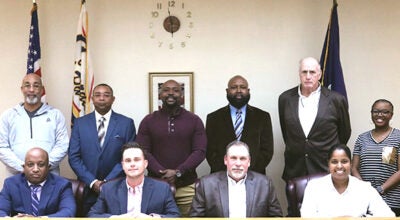Cathedral students get robotics help from NASA
Published 12:06 am Saturday, November 7, 2015

NASA robotics engineer Lucien Junkin introduces the world of robotics to the Cathedral students who will be participating in the upcoming Mississippi Science Olympiad in April. (Ben Hillyer / Natchez Democrat)
NATCHEZ — When Eden McMillin finishes her robotic arm for the Mississippi Science Olympiad, she may put a NASA symbol on it.
That would be justified for the Cathedral student since her work is built using NASA-donated equipment.
McMillin, 17, is one of the first Cathedral students scheduled to compete in robotics at the MSO, a series of science-related competitions.
And, this year, that includes robotics.
“It’s something that has definitely captured their imagination,” science teacher Jamie Gibson said.
“As soon as we found out about it, I started doing research on robotic equipment.”
As one of the school’s MSO coaches, Gibson is helping students build an electrical vehicle and a robotic arm for the events.
But outside of a summer course, Gibson didn’t have any previous robotics experience. So she called on a 1984 Cathedral alumnus for help.
NASA robotics engineer Lucien Junkin came to the school at the beginning of October to talk to students, giving tips and a pep talk.
“He came in and kind of gave us a little boost to help us out,” McMillan said.
Junkin also helped the school get approximately $2,000 in robotics equipment from NASA.
“They see, in the end, these students may not become NASA robotics engineers, but they see it sparks that interest,” Gibson said.
Currently, students are still putting together their robots. Abby Brown, 18, Colter Cauthen, 17, and Garrett Wilson, 17, are part of the team working on an electrical vehicle.
“We’re both kind of looking into mechanical engineering,” Brown said, referring to her and Cauthen “So this is a good start, a peek at what mechanical engineering could actually be.”
Wilson is considering being a mechanic rather than a mechanical engineer. In the past, he’s taken on projects such as rebuilding the inside of his car.
“This is a totally different ballgame,” Wilson said.
A car, unlike their project, has a blueprint, Wilson said. While the students have a goal, making the vehicle travel 9 to 12 meters in competition, how they accomplish that is up to the students to figure out.
“You just have to think outside the box,” Logan Young said.
Like the electrical car team, the robotic arm team doesn’t have a blueprint.
Logan Young, 17, said the easiest way to construct the robot might not be the best for competition since it has to be designed to beat other teams.
“You just have to think outside the box,” Young said.
“You can’t just think up and down. You have to think left and right, too.”
Over time, the arm has had to be taken apart and rebuilt several times, and it’s frustrating when it happens, McMillin said. When it works, it’s all worth it.
“It’s really satisfying and exciting because we’re that much closer,” McMillin said.
The competition for the mechanical arm is in February; the electrical vehicle competition is in April.
“I look at this being one of the toughest competitions for us because it’s brand new for us,” Gibson said.
But Gibson said it’s not stopping them from aiming high. Eventually, Gibson hopes the program will grow even if it’s not part of the MSO.
“Let us get our feet wet and kind of learn and build from there,” Gibson said.






